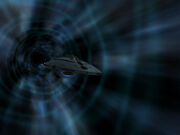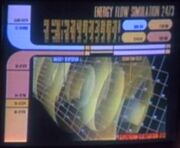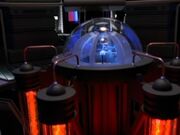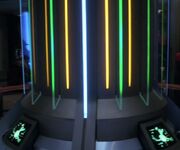(Undo revision 1668793 by Pseudohuman (talk) ... So? That doesn't invalidate velocity = distance / time.) |
|||
| (19 intermediate revisions by 13 users not shown) | |||
| Line 2: | Line 2: | ||
[[File:Quantum slipstream.jpg|thumb|''Voyager'' navigates the slipstream]] |
[[File:Quantum slipstream.jpg|thumb|''Voyager'' navigates the slipstream]] |
||
[[File:Slipstream display.jpg|thumb|A computer simulation of a slipstream]] |
[[File:Slipstream display.jpg|thumb|A computer simulation of a slipstream]] |
||
| − | The '''quantum slipstream drive''' was an advanced form of propulsion technology first encountered by the {{USS|Voyager}} in the [[Delta Quadrant]], which had the capability of exceeding a [[starship]]'s maximum [[warp factor]] by an unprecedented degree. Similar in principle to the [[transwarp]] technology utilized by the [[Borg]], it was originally developed by a Delta Quadrant race designated by the Borg as "[[Species 116]]." |
+ | The '''quantum slipstream drive''' was an advanced form of propulsion technology first encountered by the {{USS|Voyager}} in the [[Delta Quadrant]], which had the capability of exceeding a [[starship]]'s maximum [[warp factor]] by an unprecedented degree. Similar in principle to the [[transwarp]] technology utilized by the [[Borg]], it was originally developed by a Delta Quadrant race designated by the Borg as "[[Species 116]]." ({{VOY|Hope and Fear}}) |
==Technical data== |
==Technical data== |
||
| − | Quantum slipstream drive operated by routing [[energy]] through the vessel's [[main deflector]], which then focused a [[quantum field]], allowing the vessel to penetrate the quantum barrier. In order to maintain the slipstream, the [[phase variance]] of the quantum field had to be constantly adjusted, or the slipstream would collapse, violently throwing the ship back into normal space. |
+ | Quantum slipstream drive operated by routing [[energy]] through the vessel's [[main deflector]], which then focused a [[quantum field]], allowing the vessel to penetrate the quantum barrier. In order to maintain the slipstream, the [[phase variance]] of the quantum field had to be constantly adjusted, or the slipstream would collapse, violently throwing the ship back into normal space. ({{VOY|Hope and Fear}}) |
{{bginfo|According to ''[[Star Trek Encyclopedia]]'' (3rd ed., p.651), the slipstream was created through [[subspace]].}} |
{{bginfo|According to ''[[Star Trek Encyclopedia]]'' (3rd ed., p.651), the slipstream was created through [[subspace]].}} |
||
==History== |
==History== |
||
| − | [[File:Dauntless quantum slipstream drive core.jpg|thumb|left|The ''Dauntless''{{'}} |
+ | [[File:Dauntless quantum slipstream drive core.jpg|thumb|left|The ''Dauntless''{{'}} quantum slipstream drive]] |
| − | The ''Voyager'' crew first encountered slipstream technology in 2374, when they discovered the {{USS|Dauntless}}, a vessel ostensibly sent by [[Starfleet]] to transport them back to the [[Alpha Quadrant]]. It was subsequently discovered, however, that the vessel was an elaborate ruse by an alien named [[Arturis]], who was seeking revenge on [[Captain]] [[Kathryn Janeway|Janeway]] for what he saw as [[Borg-Species 8472 War|her complicity]] in the [[assimilation]] of his species by [[Borg Collective|the Borg]]. Planning to use the ''Dauntless'' to transport the ''Voyager'' crew back to his Borg-conquered homeworld for assimilation, Arturis settled for Janeway and [[Seven of Nine]] when his plot was discovered. Arturis was pursued in the slipstream by ''Voyager'', which had been outfitted with the same technology. [[Lieutenant Commander]] [[Tuvok]] managed to breach the ''Dauntless''{{'}} |
+ | The ''Voyager'' crew first encountered slipstream technology in 2374, when they discovered the {{USS|Dauntless}}, a vessel ostensibly sent by [[Starfleet]] to transport them back to the [[Alpha Quadrant]]. It was subsequently discovered, however, that the vessel was an elaborate ruse by an alien named [[Arturis]], who was seeking revenge on [[Captain]] [[Kathryn Janeway|Janeway]] for what he saw as [[Borg-Species 8472 War|her complicity]] in the [[assimilation]] of his species by [[Borg Collective|the Borg]]. Planning to use the ''Dauntless'' to transport the ''Voyager'' crew back to his Borg-conquered homeworld for assimilation, Arturis settled for Janeway and [[Seven of Nine]] when his plot was discovered. Arturis was pursued in the slipstream by ''Voyager'', which had been outfitted with the same technology. [[Lieutenant Commander]] [[Tuvok]] managed to breach the ''Dauntless''{{'}} [[shields]] with a [[photon torpedo]], allowing them to rescue Janeway and Seven. [[Commander]] [[Chakotay]] subsequently ordered their slipstream altered in order to avoid Borg space, leaving Arturis to be assimilated. ''Voyager'' remained in the slipstream for an hour before it collapsed, traversing three hundred [[light year]]s, although their diagnostics concluded that they could not risk using the technology again. ({{VOY|Hope and Fear}}) |
[[File:Voyager's slipstream drive.jpg|thumb|''Voyager''{{'}}s slipstream drive]] |
[[File:Voyager's slipstream drive.jpg|thumb|''Voyager''{{'}}s slipstream drive]] |
||
| − | [[2375|The next year]], the ''Voyager'' crew constructed their own quantum slipstream drive using [[benamite]] crystals, overcoming some difficulties in their first attempt. Despite promising potential results, [[Tom Paris]] discovered a [[phase variance]] in the slipstream threshold, threatening to overload the drive's [[quantum matrix]] and destroy the ship. [[Harry Kim]] realized that the smaller size of a piloted [[shuttle]] leading ''Voyager'' could allow early phase variance detection of the complex, dynamic slipstream threshold for the larger ship. |
+ | [[2375|The next year]], the ''Voyager'' crew constructed their own quantum slipstream drive using [[benamite]] crystals, overcoming some difficulties in their first attempt. Despite promising potential results, [[Tom Paris]] discovered a [[phase variance]] in the slipstream threshold, threatening to overload the drive's [[quantum matrix]] and destroy the ship. [[Harry Kim]] realized that the smaller size of a piloted [[shuttle]] leading ''Voyager'' could allow early phase variance detection of the complex, dynamic slipstream threshold for the larger ship. These advance data and corrections would help ''Voyager'' safely navigate the quantum slipstream. During the test flight, with Chakotay piloting the ''[[Delta Flyer]]'', Kim sent wrong correction values to ''Voyager'', causing the slipstream to unexpectedly collapse ten light years near the [[Alpha Quadrant]]. ''Voyager'' [[crash landing|crashed]] on an [[class L]] [[Unnamed_Alpha_and_Beta_Quadrant_planets#Takara_sector_planet|planet]] in the [[Takara sector]], killing all hands – however, ahead of ''Voyager'' in the stable ''Delta Flyer'' slipstream, Kim and Chakotay survived the disastrous test and returned to [[Earth]], filled with guilt. [[2390|Fifteen years later]], the pair acquired a stolen Borg [[temporal transmitter]] and recovered [[The Doctor]]'s program from ''Voyager''{{'}}s debris, and [[Janeway Factor|attempted to change history]] by allowing ''Voyager'' to stay in the slipstream. With The Doctor's expertise of Seven of Nine's physiology, Kim and Chakotay used the Borg technology to transmit a [[time index]] and new phase corrections [[time travel|back in time]] to Seven of Nine's [[interplexing beacon]]. The initial corrections did not work – with no chance to correct their mistake, The Doctor convinced Kim to give up on the Alpha Quadrant and at least avert the disaster by transmitting information which would end the flight rather than prolong it. As Seven implemented these new corrections, the slipstream dispersed and returned ''Voyager'' safely to normal space – eliminating approximately ten years from their journey to the Alpha Quadrant. ({{VOY|Timeless}}) |
| + | The [[Think Tank]] requested quantum slipstream technology as part of the payment for solving the "[[Hazari]] paradox". Captain Janeway warned [[Kurros]] that they never managed to get the technology to work reliably. Kurros commented that it was still intriguing, "theoretically." ({{VOY|Think Tank}}) |
||
| ⚫ | |||
| + | |||
| ⚫ | |||
| ⚫ | |||
* [[Subspace vortex]] |
* [[Subspace vortex]] |
||
* [[Transwarp]] |
* [[Transwarp]] |
||
* [[Transwarp drive]] |
* [[Transwarp drive]] |
||
| ⚫ | |||
=== Appearances === |
=== Appearances === |
||
<div class="appear"> |
<div class="appear"> |
||
| Line 26: | Line 28: | ||
** {{e|Hope and Fear}} |
** {{e|Hope and Fear}} |
||
** {{e|Timeless}} |
** {{e|Timeless}} |
||
| − | ** {{e|Think Tank}} |
+ | ** {{e|Think Tank}} (Mentioned) |
</div> |
</div> |
||
| Line 32: | Line 34: | ||
The quantum slipstream core prop is made up of a novelty {{w|plasma globe}} and "bubble tubes", available from most joke/gadget shops. (''[[Delta Quadrant (reference book)|Delta Quadrant: The Unofficial Guide to Voyager]]'', p. 248) |
The quantum slipstream core prop is made up of a novelty {{w|plasma globe}} and "bubble tubes", available from most joke/gadget shops. (''[[Delta Quadrant (reference book)|Delta Quadrant: The Unofficial Guide to Voyager]]'', p. 248) |
||
| − | The drive was discussed in detail in the "Briefing: Propulsion Systems" article |
+ | The drive was discussed in detail in the "Briefing: Propulsion Systems" article in ''[[Star Trek: The Magazine Volume 2, Issue 4]]''. |
| − | + | The [http://andromeda.wikia.com/wiki/Slipstream slipstream drive] became a more prominently featured method of FTL propulsion in [[Gene Roddenberry]]'s ''Andromeda'' sci-fi series that premiered in {{y|2000}}. |
|
| + | |||
| + | Based on the 300-light year trip in "Hope and Fear", the average speed of a quantum slipstream drive calculates out to 2.63 x 10<sup>6</sup> times the [[speed of light]]. |
||
=== Apocrypha === |
=== Apocrypha === |
||
The ''[[Star Trek: Destiny]]'' trilogy introduced the ''Vesta''-class starships, a testbed for a Federation quantum slipstream drive, along with numerous other technologies. |
The ''[[Star Trek: Destiny]]'' trilogy introduced the ''Vesta''-class starships, a testbed for a Federation quantum slipstream drive, along with numerous other technologies. |
||
| − | In ''[[A Singular Destiny]]'' Starfleet began to install quantum slipstream drives on its vessels |
+ | In ''[[A Singular Destiny]]'' Starfleet began to install quantum slipstream drives on its vessels in [[2381]]. Due to the nature of the technology, not all ships were compatible with the upgrade. An upgraded version of the technology proved to be successful, and in the novel ''[[Full Circle]]'' Starfleet mounted an expedition to the Delta Quadrant by outfitting ''Voyager'' and several other starships with a fully functional version of the drive. |
| − | In the ''[[Star Trek: Typhon Pact]]'' novel |
+ | In the ''[[Star Trek: Typhon Pact]]'' novel ''[[Zero Sum Game]]'', set in [[2382]], the [[Breen]] sent an operative to [[Utopia Planitia Fleet Yards]] to capture data pertaining to the Federation quantum slipstream drive, regarding it as a potential Federation weapon that would allow them to deliver a decisive first strike in any war between the Breen and their new allies in the {{mbeta|Typhon Pact}}, including the [[Romulan]]s, the [[Gorn]], the [[Tzenkethi]], the {{mbeta|Kinshaya}}, and the [[Tholian]]s. The Breen were then contracted to build the first Typhon Pact prototype slipstream vessel. The lead researcher of the project, Thot Keer, intentionally withheld information from the other members relating to the drives development, in order to promote the Breen to a level of Pact authority equal to the Romulans. Shortly before the initial trials, the prototype, its designer, and all information relating to the project were destroyed. |
| + | In ''[[Plagues of Night]]'', set in [[2383]], various members of the Pact, led by [[Sela]], attempted to travel to the [[Gamma Quadrant]] to obtain [[Jem'Hadar]] technology to perfect the drive. They believed that Jem'Hadar ships possessed the right structure to cope with the stresses of slipstream. The attempt resulted in the destruction of [[Deep Space 9]], when bombs planted to cause a diversion while they used the [[Bajoran wormhole]] caused more damage than was intended. Further attempts to develop the drive came to an end in ''[[Raise the Dawn]]'', when the Romulan Praetor officially denounced the Pact's attempt to build a drive, noting that attempts to do so have caused more problems with the Federation than the original existence of the drive, ending their attempts for the time being. |
||
| − | In ''[[Star Trek Online]]'', players are able to use slipstream drives for brief periods after reaching Vice Admiral rank in order to travel faster between star systems. |
||
| + | |||
| + | In ''[[Star Trek Online]]'', players are also able to use slipstream drives for brief periods after reaching Vice Admiral rank in order to travel faster between star systems. Two ships use advanced slipstream drives: The ''Odyssey''-class allows for extended usage while the Multi-Mission Explorer series of ships, when two special devices are used, grants this the fastest warp drive level, reaching a theoretical Warp 25 without modifications and a maximum of Warp 67.56 utilizing bonuses and special items. The 2014 Risian Summer Event added in the Risian Luxury Cruiser, which gave it the Solar Sail Quantum Slipstream Drive, which made it faster than a ship's natural Quantum Slipstream, but was slower than the special slipstreams used by the ''Odyssey'' and Multi-Mission Explorer series. |
||
=== External link === |
=== External link === |
||
* {{NCwiki}} |
* {{NCwiki}} |
||
| ⚫ | |||
[[cs:Kvantový proudový pohon]] |
[[cs:Kvantový proudový pohon]] |
||
| Line 55: | Line 60: | ||
[[fr:Moteur à sillage quantique]] |
[[fr:Moteur à sillage quantique]] |
||
[[ru:Квантовый слипстрим]] |
[[ru:Квантовый слипстрим]] |
||
| ⚫ | |||
Revision as of 16:46, 9 December 2014
AT: "xx"

Voyager navigates the slipstream

A computer simulation of a slipstream
The quantum slipstream drive was an advanced form of propulsion technology first encountered by the USS Voyager in the Delta Quadrant, which had the capability of exceeding a starship's maximum warp factor by an unprecedented degree. Similar in principle to the transwarp technology utilized by the Borg, it was originally developed by a Delta Quadrant race designated by the Borg as "Species 116." (VOY: "Hope and Fear")
Technical data
Quantum slipstream drive operated by routing energy through the vessel's main deflector, which then focused a quantum field, allowing the vessel to penetrate the quantum barrier. In order to maintain the slipstream, the phase variance of the quantum field had to be constantly adjusted, or the slipstream would collapse, violently throwing the ship back into normal space. (VOY: "Hope and Fear")
History

The Dauntless' quantum slipstream drive
The Voyager crew first encountered slipstream technology in 2374, when they discovered the USS Dauntless, a vessel ostensibly sent by Starfleet to transport them back to the Alpha Quadrant. It was subsequently discovered, however, that the vessel was an elaborate ruse by an alien named Arturis, who was seeking revenge on Captain Janeway for what he saw as her complicity in the assimilation of his species by the Borg. Planning to use the Dauntless to transport the Voyager crew back to his Borg-conquered homeworld for assimilation, Arturis settled for Janeway and Seven of Nine when his plot was discovered. Arturis was pursued in the slipstream by Voyager, which had been outfitted with the same technology. Lieutenant Commander Tuvok managed to breach the Dauntless' shields with a photon torpedo, allowing them to rescue Janeway and Seven. Commander Chakotay subsequently ordered their slipstream altered in order to avoid Borg space, leaving Arturis to be assimilated. Voyager remained in the slipstream for an hour before it collapsed, traversing three hundred light years, although their diagnostics concluded that they could not risk using the technology again. (VOY: "Hope and Fear")

Voyager's slipstream drive
The next year, the Voyager crew constructed their own quantum slipstream drive using benamite crystals, overcoming some difficulties in their first attempt. Despite promising potential results, Tom Paris discovered a phase variance in the slipstream threshold, threatening to overload the drive's quantum matrix and destroy the ship. Harry Kim realized that the smaller size of a piloted shuttle leading Voyager could allow early phase variance detection of the complex, dynamic slipstream threshold for the larger ship. These advance data and corrections would help Voyager safely navigate the quantum slipstream. During the test flight, with Chakotay piloting the Delta Flyer, Kim sent wrong correction values to Voyager, causing the slipstream to unexpectedly collapse ten light years near the Alpha Quadrant. Voyager crashed on an class L planet in the Takara sector, killing all hands – however, ahead of Voyager in the stable Delta Flyer slipstream, Kim and Chakotay survived the disastrous test and returned to Earth, filled with guilt. Fifteen years later, the pair acquired a stolen Borg temporal transmitter and recovered The Doctor's program from Voyager's debris, and attempted to change history by allowing Voyager to stay in the slipstream. With The Doctor's expertise of Seven of Nine's physiology, Kim and Chakotay used the Borg technology to transmit a time index and new phase corrections back in time to Seven of Nine's interplexing beacon. The initial corrections did not work – with no chance to correct their mistake, The Doctor convinced Kim to give up on the Alpha Quadrant and at least avert the disaster by transmitting information which would end the flight rather than prolong it. As Seven implemented these new corrections, the slipstream dispersed and returned Voyager safely to normal space – eliminating approximately ten years from their journey to the Alpha Quadrant. (VOY: "Timeless")
The Think Tank requested quantum slipstream technology as part of the payment for solving the "Hazari paradox". Captain Janeway warned Kurros that they never managed to get the technology to work reliably. Kurros commented that it was still intriguing, "theoretically." (VOY: "Think Tank")
Appendices
See also
Appearances
- VOY:
- "Hope and Fear"
- "Timeless"
- "Think Tank" (Mentioned)
Background Information
The quantum slipstream core prop is made up of a novelty plasma globe and "bubble tubes", available from most joke/gadget shops. (Delta Quadrant: The Unofficial Guide to Voyager, p. 248)
The drive was discussed in detail in the "Briefing: Propulsion Systems" article in Star Trek: The Magazine Volume 2, Issue 4.
The slipstream drive became a more prominently featured method of FTL propulsion in Gene Roddenberry's Andromeda sci-fi series that premiered in 2000.
Based on the 300-light year trip in "Hope and Fear", the average speed of a quantum slipstream drive calculates out to 2.63 x 106 times the speed of light.
Apocrypha
The Star Trek: Destiny trilogy introduced the Vesta-class starships, a testbed for a Federation quantum slipstream drive, along with numerous other technologies.
In A Singular Destiny Starfleet began to install quantum slipstream drives on its vessels in 2381. Due to the nature of the technology, not all ships were compatible with the upgrade. An upgraded version of the technology proved to be successful, and in the novel Full Circle Starfleet mounted an expedition to the Delta Quadrant by outfitting Voyager and several other starships with a fully functional version of the drive.
In the Star Trek: Typhon Pact novel Zero Sum Game, set in 2382, the Breen sent an operative to Utopia Planitia Fleet Yards to capture data pertaining to the Federation quantum slipstream drive, regarding it as a potential Federation weapon that would allow them to deliver a decisive first strike in any war between the Breen and their new allies in the Typhon Pact at Memory Beta, the wiki for licensed Star Trek works, including the Romulans, the Gorn, the Tzenkethi, the Kinshaya at Memory Beta, the wiki for licensed Star Trek works, and the Tholians. The Breen were then contracted to build the first Typhon Pact prototype slipstream vessel. The lead researcher of the project, Thot Keer, intentionally withheld information from the other members relating to the drives development, in order to promote the Breen to a level of Pact authority equal to the Romulans. Shortly before the initial trials, the prototype, its designer, and all information relating to the project were destroyed.
In Plagues of Night, set in 2383, various members of the Pact, led by Sela, attempted to travel to the Gamma Quadrant to obtain Jem'Hadar technology to perfect the drive. They believed that Jem'Hadar ships possessed the right structure to cope with the stresses of slipstream. The attempt resulted in the destruction of Deep Space 9, when bombs planted to cause a diversion while they used the Bajoran wormhole caused more damage than was intended. Further attempts to develop the drive came to an end in Raise the Dawn, when the Romulan Praetor officially denounced the Pact's attempt to build a drive, noting that attempts to do so have caused more problems with the Federation than the original existence of the drive, ending their attempts for the time being.
In Star Trek Online, players are also able to use slipstream drives for brief periods after reaching Vice Admiral rank in order to travel faster between star systems. Two ships use advanced slipstream drives: The Odyssey-class allows for extended usage while the Multi-Mission Explorer series of ships, when two special devices are used, grants this the fastest warp drive level, reaching a theoretical Warp 25 without modifications and a maximum of Warp 67.56 utilizing bonuses and special items. The 2014 Risian Summer Event added in the Risian Luxury Cruiser, which gave it the Solar Sail Quantum Slipstream Drive, which made it faster than a ship's natural Quantum Slipstream, but was slower than the special slipstreams used by the Odyssey and Multi-Mission Explorer series.
External link
- Template:NCwiki
